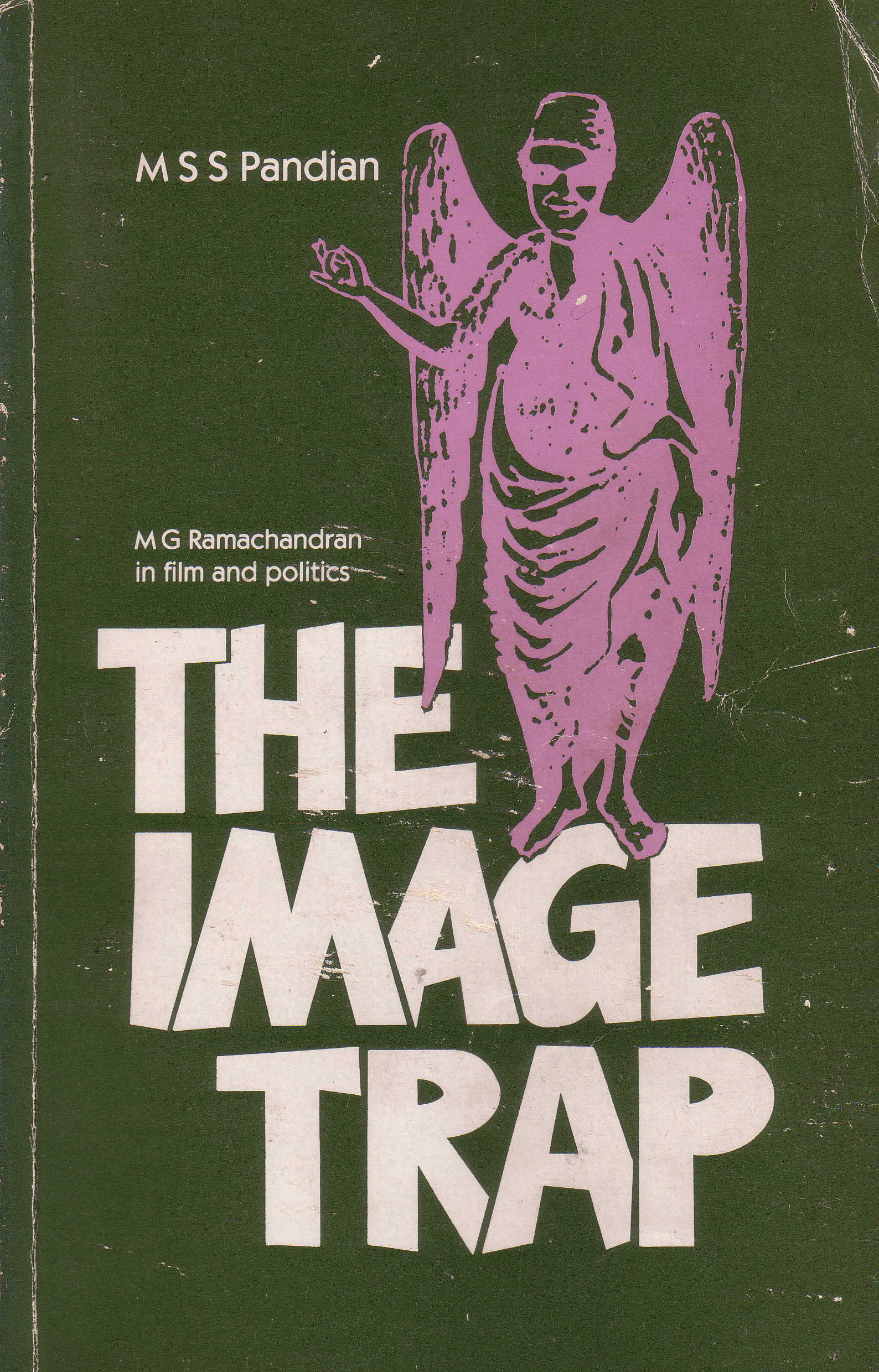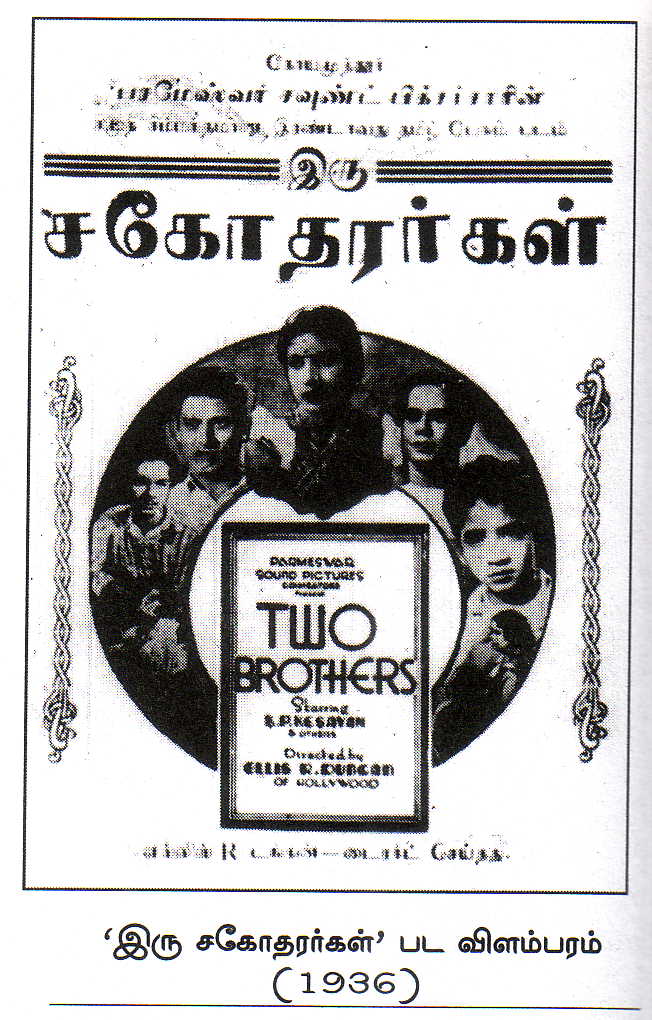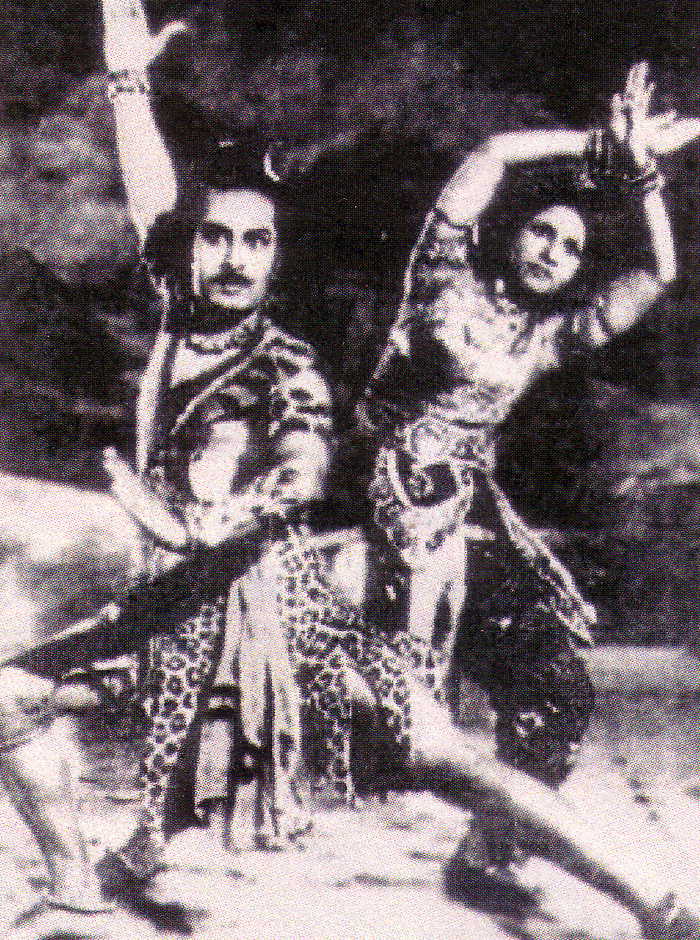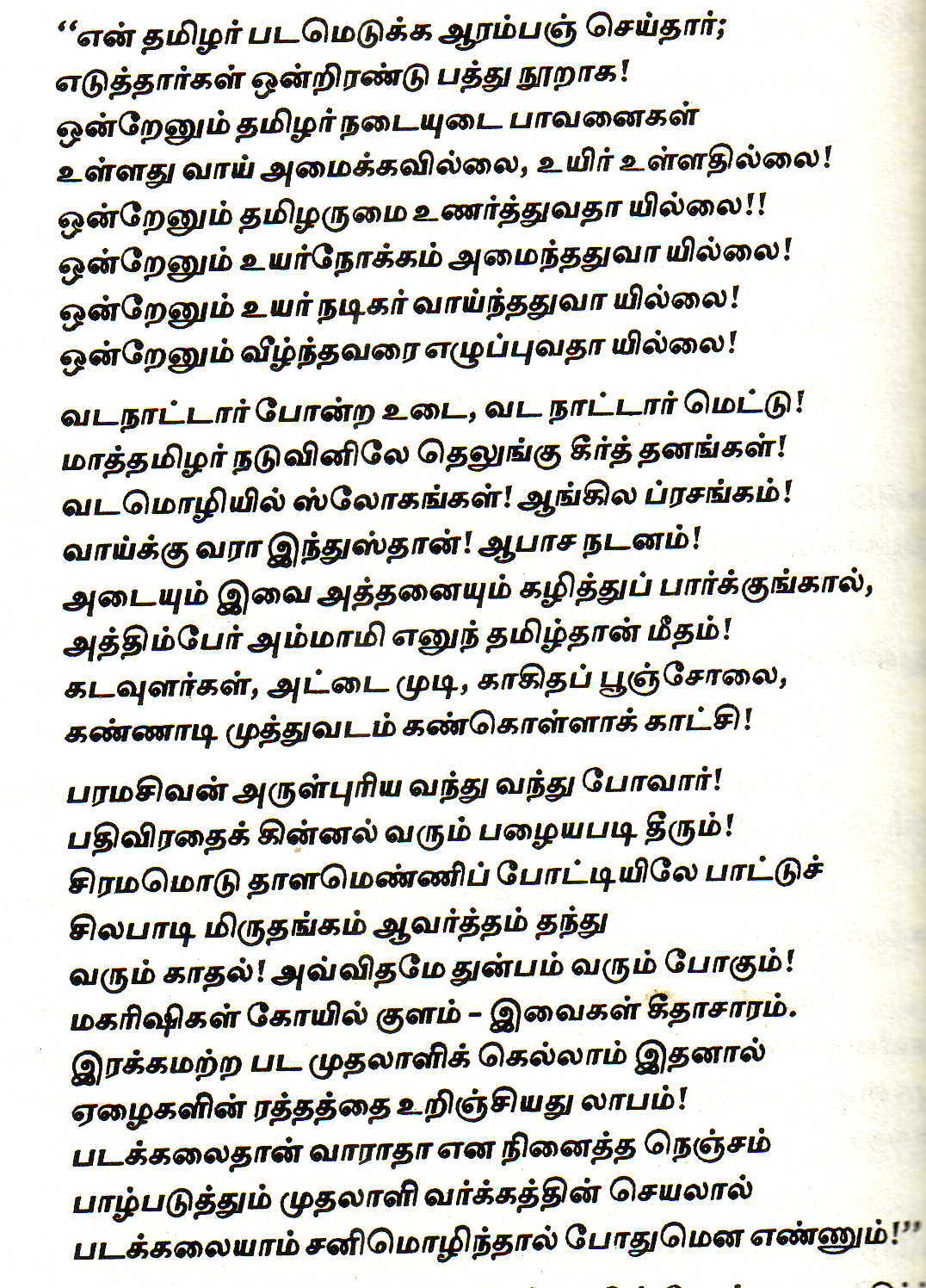by Sachi Sri Kantha, May 3, 2013
In Love with Temperance theme
The Sathi Leelavathi (1936) movie, in which MGR debuted, had temperance in its plot. One thing which became certain was that MGR, for the whole 40 years of his movie career which spanned 133 movies, made the temperance theme as his center pillar of his movie image. He might have ignored other Gandhian values, but on this temperance theme as well as non-torture of women, he was unshakable. He detested having scripts in which his character had to imbibe alcohol. By sticking to his conviction, he narrowed the range of characters he could play. Many Tamil movie critics had ridiculed this wooden, two-dimensional nature of MGR’s movie characters which could never ever flout these two virtues of temperance and non-torture of women. His biographer Pandian calls it derisively as, “meticulously constructed image”. One may be tempted to ask, what is wrong in it? Is it a sin to preach temperance and non-torture of women in movies? Pandian also has observed, “he (MGR, that is) asked lyric writers to introduce changes in them to suit his image”.
 But, MGR earned the merits and votes of women folk because of this adamancy. Occasionally, MGR did permit his movie character to use alcohol in song sequences. Pandian’s gripe can be answered easily. In MGR’s conviction, songs should be of educational value, in addition to its entertaining function. In Indian culture (as well as other cultures), songs were an important vehicle for cultural education since ages. As such, alcohol use for his character was allowed either under the pretext of play-acting as a drunkard (in the 1963 Pana Thottam (Money Garden) movie, for the duet song ‘Javvathu Medai Iddu’ with the heroine) or as a conflict between the two components of Freudian structural model of psyche – ego (which acts according to the reality principle) and super ego or conscience (which aims for perfection). The latter example was featured in MGR’s 100th movie Oli Villaku (Light Lamp), as a solo song ‘Thairiyamaha Sol Nee Manithan Thaana?’(Would you tell courageously whether you are a human?). Five images of MGR appear in screen for this song.
But, MGR earned the merits and votes of women folk because of this adamancy. Occasionally, MGR did permit his movie character to use alcohol in song sequences. Pandian’s gripe can be answered easily. In MGR’s conviction, songs should be of educational value, in addition to its entertaining function. In Indian culture (as well as other cultures), songs were an important vehicle for cultural education since ages. As such, alcohol use for his character was allowed either under the pretext of play-acting as a drunkard (in the 1963 Pana Thottam (Money Garden) movie, for the duet song ‘Javvathu Medai Iddu’ with the heroine) or as a conflict between the two components of Freudian structural model of psyche – ego (which acts according to the reality principle) and super ego or conscience (which aims for perfection). The latter example was featured in MGR’s 100th movie Oli Villaku (Light Lamp), as a solo song ‘Thairiyamaha Sol Nee Manithan Thaana?’(Would you tell courageously whether you are a human?). Five images of MGR appear in screen for this song.
Biographer Pandian’s incomplete portrayal of MGR
Pandian had covered MGR’s pre-hero years in Tamil movies (a period of 10 years, from 1936 to 1947) in merely three sentences, as follows:
“During his early film career, MGR was compelled by circumstances to play minor roles in several films, including mythological ones. He appeared as Vishnu in Dakshayagnam (1938), as Indiran in Prahalada (1939), as Parameswarar in Sri Murugan (1946) and as Indirajit in Seetha Jananam (1947). And he appeared, for the first time, as the hero in Jupitor Pictures’ Rajakumari (1947), which was directed by A.S.A. Samy.”
Pandian’s biography was reviewed by V. Jayanth in The Hindu daily. Here is the first half of this review.
“MGR the phenomenon provides enough material for any number of books and theories. The fact was that in his life and death, he defied all theories and created a niche for himself that will be difficult to erase or understand.
And this is precisely what the author, Pandian, a fellow of the Madras Institute of Development Studies, tries to explore in his book. Unfortunately, it appears to be a biased picture, because he is trying to fit into his own trap, the events and policies of MGR the actor and politician.
There can be no escaping the fact that Tamil Nadu’s political stage has been closely interlocked with the theatre and cinema here even since the Dravidian movement took deep political roots. The DMK made political capital out of the dialogue-writing skills of its leaders C.N. Annadurai and M. Karunanidhi and it was MGR who had to mouth them to capture the imagination of the youth of the 1960s.
Pandian has taken trouble, like a true researcher, to study so many publications and writings on MGR, but the pity is he has relied too much on some sources which do not carry the kind of weight or conviction to knowledgeable readers…”
I concur with the inference made by reviewer Jayanth in the last quoted paragraph. In my opinion, Pandian’s laborious study suffers from lack of internal controls (such as Indian film plots acted by MGR’s contemporaries – especially Tamil, Telugu, Kannada, Malayalam and Hindi) as well as lack of external controls (film plots from Hollywood, or even other languages such as Russian, Chinese or Japanese) in the same period MGR made his movies. I’ll deal with this issue in a forthcoming part. In this part, I wish to add more on the pre-hero decade of MGR. This is because, the travails and rejections, combined with low pay, less opportunities and death of his young first wife he faced while establishing his career, made MGR a man of character.

MGR’s second movie which was also released in 1936 was Iru Sahodarargal (Two Brothers), again had a social plot. Tamil movie historian Aranthai Narayanan had provided the following background to this movie. Chakravarthi Rajagopalachariar (popularly known as Rajaji), a prominent pre-Independent Congress leader had an unfavorable opinion about cinema then. He thought it promotes decadence. The producer Coimbatore P. Ramasamy’s goal was to prove that movies could be used to influence societal needs. He was keen to attract the attention of Rajaji and somehow managed to invite him for a viewing. Only after listening the movie’s story line, Rajaji consented to appear for a viewing, and he was highly impressed. The entire collection of that day was handed to Rajaji, for the ‘Patel fund’ then being collected by the freedom fighters. In this movie, MGR was in a minor role, again playing a policeman, the same as his debut movie Sathi Leelavathi. The hero of this movie was K.P. Kesavan, one of MGR’s mentor in stage.
Ellis Dungan who directed the movie had reminisced the following in his 2001 autobiography. The promotional poster for this movie states in English, “Directed by Ellis R. Duncan of Hollywood”.
“I was approached by Parmeswar Sound Pictures of Coimbatore to direct another social film titled Iru Sahodaragal (Two Brothers), to be produced at Saraj Movietone Studios in Bombay. As was the case with Sathi Leelavathi, the cast came from the stage. So again I had to take on the task of subduing the actors’ voices and facial expressions. We completed ‘Two Brothers’ in about three months…
The writers who wrote the promotional pieces for my Indian films really had a way with words. One piece described the film, ‘Two Brothers’ as ‘a powerful drama depicting the human emotions of love, hatred, jealousy, laughter, sorrow, anger and happiness…
While I was still in Bombay, having just wrapped up the film, my stepsister Margaret Kennedy arrived in India from the US. We traveled to Madras just in time to attend the premiere of ‘Two Brothers’, and I quote from Margaret from a 1937 Wheeling newspaper clipping, after her return to the US: ‘All the Indian critics say that this is the best Tamil picture of the year. It is really very good considering the handicaps Ellis had to work under. The audiences are very interesting, with the women sitting on one side of the theater and the men on the other…”
Poet Bharathidasan’s satire on Tamil movies of 1930s
Though Dungan’s stepsister had favorable words for the ‘Two Brothers’ movie, one Tamil poet poured scorn on the quality of the Tamil movies. He was none other than the renowned atheist, Tamil nationalist poet Bharathidasan (1891-1964), whose collection of poems also appeared in 1936. Aranthai Narayanan had reproduced this biting satirical poem, with the title ‘Cinema in Tamil Nadu’ in his book. I provide the Tamil original in a scan. Though my English translation of this poem won’t do justice for the beauty of the original, I provide it for its relevance to the theme covered here.
My Tamilians began to take movies;
They did it in one, tens and hundreds.
Not even one had the Tamil style, culture and imprints
They didn’t make it that way, life is non-extant!
Not even one raises the Tamilian’s spirit!
Not even one was based on higher ideals!
Not even one had a high rated actor!
Not even one lifts the spirit of down trodden!
Dresses akin to Northerners, and melody of Northerners!
Telugu kirtanas (songs) filled amidst our Tamilians
Slogas in Sanskrit! Speeches in English!
Unpronounceable Hindustani! Obscene dances!
All mixed – and deducting all these junk
Athimper and Ammami are the remaining Tamil words!
Gods of many kinds, false crown, with paper flower garden
Glasses and pearl strings – the attractive accouterment
Lord Shiva appears repeatedly to offer blessings and return!
Homely wives face toils, but overcome them!
There’ll be tough song contests with rhythm
Then the drum (mridangam) will engage a solo stint
Love blooms! Similarly troubles come and leave!
Maharishis, temple and lake – these fill the space
Movie moguls – the suckers, had the formula
to suck the blood of poor souls for profit!
When one thinks about the fate of this movie art
The Capitalists creed spoils it all by deeds
This Saturn of movie business should vanish, I guess!
True to this poem, even MGR (an atheist in heart) had to don the role of Lord Shiva in two of his early movies to perform dances with his consort Parvathi. These were, for the Dasi Penn (literally translated as ‘Prostitute Woman’ or Jyothimalar, 1943), MGR as Lord Shiva danced with R.Balasaraswathi. Then, for the movie Sri Murugan (1946), MGR danced as Lord Shiva with K. Malathi. Why? he had to sacrifice his pet ideology to make a living in the competitive industry and establish himself in the front rank. The plots of Tamil movies then were dominated by Hindu mythologicals until Annadurai’s paradigm shift in script writing occurred in late 1940s.
Ironically, even poet Bharathidasan himself dabbled in Tamil movies later to earn money as a lyricist! Or, as he or his fans may claim, to clean the frauds in the movie industry. One of his novel ‘Unexpected Kiss’ was adapted to movie under the name Ponmudi (1950, the name of hero in the story), because the original title was thought to be too controversial for the tradition-bound Tamil society; none other than Ellis Dungan directed this movie. MGR’s brother M.G. Chakrapani was cast as the villain. Randor Guy had reported that the movie bombed in box office, because Dungan had daringly included love scenes of Hollywood type and it was too shocking for the Tamil audience of 1950! It was also reported that Bharathidasan died heart-broken in 1964 because his movie dealings with Sivaji Ganesan failed due to call sheet or cash flow problems.
First 15 MGR movies in subsidiary or minor roles
Some details on the 15 movies in which MGR played subsidiary or minor roles, before he was featured as the hero in Rajakumari [Princess] in 1947 are given below. As his debut movie Sathi Leelavathi had been covered in part 7, I omit much details about it here.
A check on the cast of actors of the 15 movies MGR starred in minor roles between 1936 and 1947 offers hints relating to who were MGR’s rivals then for the hero roles. Tamil film historian Randor Guy, in his interesting series ‘Blast from the Past’ in The Hindu daily do provide background details and story synopsis for most of these movies.
Sathi Leelavathi (1936): Produced by Manorama Films. 18,000 feet. Released on March 28, 1936. Director Ellis R. Dungan, lyrics Sunthara Vathiyar, story S.S.Vasan, script Kandasamy Mudaliar. Cast: M.K. Radha, T.S.Balaiah, N.S.Krishnan, MGR, M.S.Gnanambal.
Iru Sagotharargal (1936): produced by Parameswari Sound Pictures. Director Ellis R.Dungan, lyrics S.D.S.Yogi. Cast: K.P. Kesavan, K.K. Perumal, MGR, T.S. Balaiah, P.G. Venkatesan, M.M. Radhabhai, T.S. Krishnaveni, S.N. Vijayalakshmi, S.N. Kannamani.
Daksha Yagnam (1938): produced by Metropolitan Pictures. 17,000 feet. Released on March 31, 1938. Director Rajah Chandrasekar, script K. Thyagarajah Desigar, Music N.S.Balakrishnan. Cast: V.A. Chellappa, M.G. Nataraja Pillai, P.G.Venkatesan, N.S. Krishnan, MGR, M.M. Radhabhai, K.R.Jeyalaskshmi, T.N. Chandramma, T.A.Mathuram.
Veera Jagathis (1938): Produced by V.S.Talkies. 10,444 feet. Director T.P.Kailasam and R.Prakash. Cast: V.S.M. Rajarama Iyer, MGR.
Maya Machindra (1939): Produced by Metropolitan Pictures. 19,000 feet. Released on April 22, 1939. Director Rajah Chandrasekar, script Lakshmanadas, songs Papanasam Sivan. Cast: M.K. Radha, MGR, M.G. Chakrapani, M.R.Krishnamoorthy, N.S.Krishnan, Saratha, M.R.Radhabhai, T.A. Mathuram.
Prahalatha (1939): Produced by Salem Shankar Films. 16,000 feet. Released on November 14, 1939. Director B.N.Rao, script Vadivel Naicker, songs Papanasam Sivan, Vaithianatha Iyer, music direction Sarma brothers. Cast: R.Balasubramaniam, MGR, Master T.R.Mahalingam, N.S.Krishnan, T.S. Durairaj, M.R.Santhanalakshmi, T.A.Mathuram, P.S.Gnanam.
Vedavathi or Seetha Jananam (1941): Produced by Shyamala Pictures. 16,829 feet. Released on January 11, 1941. Director T.R.Raghunath, script Raja Chandrasekar, songs Papanasam Sivan, Rajagopala Iyer, music direction T.K. Jeyarama Iyer. Cast: M.R.Krishnamoorthi, R. Balasubramaniam, MGR, N.S.Krishnan, P.G.Venkatesan, Thavami Devi, Kumari Rukmani, T.A. Mathuram, Kolar Rajam.
Ashok Kumar (1941): Produced by Murugan Talkies Film Company. 19,000 feet. Released on July 7, 1941. Director Rajah Chandrasekhar, script Ilankovan, songs Papanasam Sivan, Rajagopala Iyer, ‘Yaanai’ Vaithianatha Iyer, music direction Alandur Sivasubramaniam. Cast: K.K.Thyagaraja Bhagavathar, V. Nagiah, N.S.Krishnan, MGR, P. Kannamba, T.V.Kumudhini, T.A.Mathuram.
Thamizh Ariyum Perumal (1942): Produced by Uma Pictures. 16,000 feet. Released on April 25, 1942. Director T.R. Raghunath, script Ilankovan. Cast: V.A.Chellapa, T.S. Durairaj, R.Balasubramaniam, MGR, M.G. Chakrapani, M.R.Santhanalakshmi, M.S. Devasena, T.S. Jaya, C.T. Rajakantham.
Dasi Penn or Jyothi Malar (1943): Produced by Bhuvaneswari Pictures. 13,623 feet. Released on January 25, 1943. Director Ellis R. Dungan, music direction Lalitha Venkataraman and Saluru Rajeswara Rao. Cast: T.R. Mahalingam, MGR, N.S.Krishnan, Krishnamoorthy, R.Balasaraswathi, M.R.Santhanalakshmi, T.A.Mathuram.
Harichandra (1943): produced by Sri Rajarajeshwari Film Company. 12,485 feet. Released on December 27, 1943. Director Nagabhushanam. Script T.C.Vadivel Naicker, music direction S.V.Venkataraman, lyrics C.A.Lakshumanadas. cast: P.U.Chinnappa, M.R.Swaminanthan, R.Balasubramaniam, M.N.Nambiar, N.S.Krishnan, P. Kannamba, T.A.Mathuram, B.S. Chandra, Yogam, Mangalam.
Salivahanan (1944): produced by Bhaskar Pictures. 10,996 feet. Released on December 22, 1944. Director B.N. Rao, story, B.S. Ramaiah, script Kambadasan, lyrics Papanasam Sivan and Kambadasan. Cast: Ranjan, MGR, N.S.Krishnan, T.S.Balaiah, Nagarkovil Mahadevan, T.R. Rajakumari, K.L.V.Vasantha, M.R.Santhanalakshmi, T.A.Mathuram.
Meera (1945): produced by Chandraprabha Cinetone. 10,990 feet. Released on November 3, 1945. Director Ellis R. Dungan, producer T. Sathasivam, Story and script Kalki and Sathasivam, lyrics Papanasam Sivan, music direction S.V.Venkataraman. Cast: V. Nagaiah, Serukalatur Sama, T.S.Balaiah, MGR, T.S. DuraiRaj, M.S.Subbulakshmi, K.R. Chellam, Baby Radha.
Sri Murugan (1946): produced by Jupiter Pictures. 14,950 feet. Released on October 27, 1946. Director M. Somasundaram and V.S.Narayan. Producers Somasundaram and Mohideen, Story and script A.S.A.Sami, lyrics Papanasam Sivan, music direction S.M.Subbiah Naidu and S.V. Venkataraman. Cast: Honnappa Bhagavathar, MGR, P.S. Veerappa, Narasimha Bharathi, M.G. Chakrapani, Kali N. Ratnam, Malathi, T. Premavathi, T.V. Kumudini, U.R. Jeevaratnam, Harini, Mangalam.
Paithiakaran (1947): produced by NSK Films. 16,201 feet. Released on September 26, 1947. Director Krishnan-Panju, Producer D.Ramasamy, Story and script S.V.Sahasranamam, lyrics K.P.Kamatchi, Narayana Kavi, T.A. Sambanthamoorthy, Desika Vinayagam Pillai. Music direction C.R. Subbaraman and M.S.Gnanamani. Cast: S.V.Sahasranamam, N.S. Krishnan, MGR, D. Balasubramaniam, T.A. Mathuram, S.T. Kantha, S.R. Janaki.
Among these 15 movies, more than half were based on Hindu mythological plots; 4 were directed by Ellis R. Dungan, 3 by Raja Chandrasekar and 2 by T.R. Raghunath. Randor Guy had noted the following information:
Daksha Yagnam (1938), Thamizh Ariyum Perumal (1942) and Salivahanan (1944) movies did not fare well at the box office.
Dasi Penn (1943, Woman Prostitute) performed fairly well at the box office, but ‘no print of this film exists today’.
Two among the 15 movies had alternate titles! Overall, MGR was fortunate enough to have minor roles in two mega-hit movies of 1940s – Ashok Kumar (1941) and Meera (1945), both due to the popularity of the songs sung by the hero (M.K. Thyagaraja Bhagavathar) and heroine (M.S. Subbulakshmi), excellent direction by Rajah Chandrasekar and Ellis Dungan, and script by Ilankovan and Kalki Krishnamoorthy plus T.Sathasivam respectively.
Ravindar. MGR’s assistant, had recorded the following reminiscence he had heard from his boss, relating to an event which happened in 1972. MGR had visited Calcutta to receive the Bharath award offered by the Central government.
“Calcutta is well known for rasgulla; not now, forever. [Rasgulla is a sweet, syrupy ball dumbling, served as a dessert.] My brother and I went to Calcutta in 1936 for the shooting of Maya Machindra movie. Do you know, what was my salary then? Two hundred (rupees). For a month, we ate what was fed by them and it was a jail experience. In those days, there were no studios in Madras.
I loved eating sweets then. I wished to eat rasgulla. One dumpling costs four anna. No money! Then, server Kuldeep who was appointed for our meals fulfilled my pleasure. After I received the award and came out, there was much crowd, shouting ‘Long live MGR’. That Kuldeep whom I saw 40 years earlier, was also standing at a side in the hotel crowd, with a garland. I had noticed him.
Then, my tongue was sweetened by the rasgulla he had offered me. Now, my heart was sweetened by seeing him. He was rather surprised to see the difference in me – what he saw then, what he sees now. I hugged him and brought him to the room. Then, he was a bachelor. Now, he said he had two grandchildren. I felt pity for him and offered something. He rejected my offer, and told that this meeting itself was heart filling. Somehow, he did accept what I offered subsequently.”
Thus, one could note that from roughly 60 rupees per month for his first movie, MGR’s earning had increased to 200 rupees per month for his fifth movie. But still, available opportunities were scarce. Even the role for which he chosen in the Maya Machindra, came his way because the actor M.G. Nadaraja Pillai who was originally contracted to play that role had died!
To his interviewer Copper Cochin, MGR had stated in 1981, “I was attracted by the ‘prohibition’ movement of Gandhiji and untouchability, equality of castes and I was enrolled in Congress movement at 13 years of age. During 1934-35, I had met N.S.Krishnan, later known as ‘Kalaivanar’, the famous film and stage comedian and social reformer who followed the ideals of Periyar [E.V. Ramasamy Naicker]. Through him I had the privilege of meeting such great people as P. Jeevanantham. It was said that Jeevanantham – who was popularly known as ‘Jeeva’ went underground often, to escape from the legal clutches of the British. Kalaivanar advised me to read Periyar’s Kudiarasu [literal translation, ‘People’s Rule’] which was a weekly then. I read the magazines written and edited by Periyar E.V.R. Hence I have grown with all these policies and principles.”
Copper Cochin had recorded what he heard from MGR as follows: “When the chances of getting cinema roles were becoming bleak he [MGR] learnt that young people who possess horse-riding training and who can converse in English were being recruited for the army. He decided to join the army. To qualify for this, he learnt horse riding and the English language through a teacher. Soon he acquired a good knowledge of spoken English with sufficient grammar, including active and passive voice. When the time came, MGR gave up the idea of joining the army because his chest measurements did not quite come upto the required standard! This proved to be his ‘lucky break’, for at this point Nandalal Jaswanthalal, the famous director and editor offered him his first starring role at the salary of Rupees 350 per month! ‘Halfway through the shooting however, the film folded and I was out of work again’, said MGR ruefully.
This particular movie Chaaya (1941) for which MGR was chosen to play the hero role joined the long list of MGR movies which were announced to begin, but failed to be completed for various number of reasons. The promotional announcement indicated that it would appear as the Pakshiraja banner. Thirteen years later, another movie with the title Malai Kallan (1954, Mountain Thief) under the same Pakshiraja banner did create history, with MGR as the hero. At that time, the monthly pay for a beginner at army was only around 125 rupees. One wonders, if he was lucky to be selected to serve the Indian army as a foot soldier, at best his talents for showmanship in movies and politics might have been lost in the next decades, or at worst he might have lost his life during India’s perennial wars with Pakistan. Thus, his non-selection to Indian army was a blessing to many who later benefitted by his patronage.
Sources
Erik Barnow and S. Krishnaswamy: Indian Film, 2nd ed., Oxford University Press, New York, 1980.
Copper Cochin: Profile – MGR, a hero on and off the screen. Spotlight on Tamil Nadu – Special Publication released on the occasion of the 5th World Tamil Conference, Madurai, January 1981, pp. 27-31.
Ellis R. Dungan with Barbara Smik: A Guide to Adventure – an autobiography, Dorrance Publishing Co., Pittsburgh, 2001, pp. 61-62.
Randor Guy: Blast from the Past ‘Daksha Yagnam’ (1938). The Hindu, Sept.25, 2011.
Randor Guy: Blast from the Past ‘Ashok Kumar’ (1941). The Hindu, Jan. 25, 2008.
Randor Guy: Blast from the Past ‘Thamiz Ariyum Perumal (1942). The Hindu, May 8, 2011.
Randor Guy: Blast from the Past ‘Dasi Penn (Jyothimalar)’ (1943). The Hindu, Feb. 20, 2011.
Randor Guy: Behind the making of the classic ‘Meera’. The Hindu, Dec. 17, 2004.
Randor Guy: Blast from the Past ‘Sri Murugan’ (1946). The Hindu, May 1, 2009.
Randor Guy: Blast from the Past ‘Paithiakaaran’ (1947). The Hindu, Jun 13, 2008.
Randor Guy: Blast from the Past ‘Pon Mudi’ (1950). The Hindu, Oct. 3, 2008.
V.Jayanth: The MGR phenomenon (review of M.S.S.Pandian’s book, The Image Trap).
The Hindu International edition, 1992.
R. Muthukumar: Vaadhyar: MGR Vazhkkai, Kizhakku Pathippagam, Chennai, 2009.
Aranthai Narayanan: Thamizh Cinemavin Kathai (The story of Tamil cinema), New Century Book House, Chennai, 3rd ed, 2008, pp. 92, 104 (in Tamil)
M.S.S. Pandian: The Image Trap – M.G.Ramachandran in Film and Politics, Sage Publications, New Delhi, 1992.
K. Ravindar: Pon Mana Chemmal MGR, Vijaya Publications, Chennai, 2009, pp.114-115 (in Tamil).


